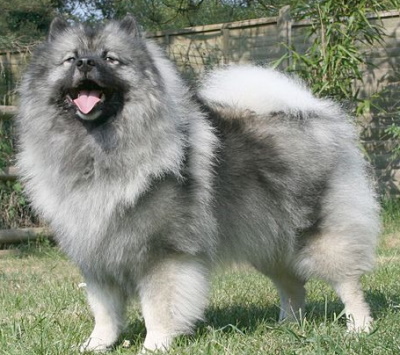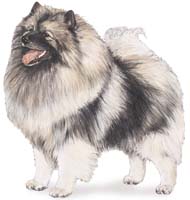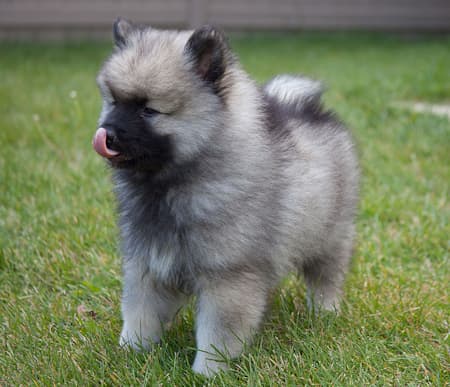Keeshond Dogs
They Need Strong Leaders!
Keeshond dogs originated from Nordic ancestors - or more specifically they are decendents of the German Wolfspitz. This old breed is well-known in many parts of Europe, but is especially associated with Holland due to its symbolic link with the Dutch Patriot party and the political events occurring in that country during the 18th century.
The Keeshond was named after the Dutch Patriot Cornelis (Kees) de Gyselaer who was a Dutch politician and a leader of the rebellion against the House of Orange. He also had a devoted Keeshond who became the rebel's mascot.
Kees in a nickname for Cornelis and hond means dog in Dutch.
When the House of Orange regained power in 1814, the breed lost popularity and nearly became extinct. Interest was restored to expand the breed's reach in the 1920s, and the American Kennel Club (AKC) recognized it in 1930.
The Keeshond is the national dog of the Netherlands.

Early in its history, the Keeshond mainly lived his life as a
companion/watchdog on farms, river boats and barges traveling the canals of the Netherlands and skillfully dispatching the vermin on board. This, undoubtedly, is
the
reason he became known as the Dutch Barge Dog.
During the late 19th century, dogs were imported into England and became the foundation of the breed there. The AKC recognized the breed in 1930.
Characteristics of Keeshond Dogs
Keeshond dogs are known for their high intelligence and love of family. They most definitely are a breed that likes to stay in
close contact with their "pack" and should not be kept outside. To keep them apart from family would be unkind and eventually
lead to troublesome behaviors.
They are very alert, protective and natural watchdogs. As is the case with most smart dogs, they need strong leaders and no
ambiguity about who's in charge. But being quick learners, an owner who trains with consistency and fairness will
reap the rewards of a very enjoyable companion.
The Keeshond dog breed has achieved considerable success in agility and
obedience events so this is a good area to consider for training which will also put you in the alpha position and give
them the structure they need.
On another note, although this dog breed is very friendly, some can be timid. For this reason, it's a good idea to socialize
them early in life the same as you would with any other breed, to build their confidence with different people, places and a variety of situations.
Puppy training class are recommended at the age of 9 to twelve weeks.
These classes teach basic commands, come, sit, stay and down and will
also socialize your puppy to behave around other dogs.
The Keeshond has a loud distinctive bark, but is not aggressive toward
those his owner welcomes. He uses his bark to warn of
approaching visitors, but will not generally become a nuisance barker
unless he is isolated for long periods and cut off from companionship.

Appearance and Grooming
The Keeshond is
an attractive medium-sized dog,
well-balanced and compactly built.
Height: 18 inches (males) 17 inches (females)
Weight: 35 to 45 pounds
The Keeshond is easily recognized by his keen facial expression with a bespectacled look around the eyes, and triangular pointed ears.
Keeshond dogs have a lush double coat that is especially profuse around the ruff, hind quarters and and richly plumed tail carried over the back. The outer coat combines a mixture of cream, gray, and black, with black being the transition color on the tips of the hair.
By contrast, the
undercoat is quite pale and is seen in much lighter shades of gray or
cream. According to the kennel club standard the undercoat should never
be tawny.
This breed sheds a lot year-round and has very heavy seasonal shedding. In between these periods, regular brushing is needed to remove
the build-up of dead hair.
Very popular grooming tools for this job are the FURminator
and the ZoomGroom. For big shedders, these two together are awesome!
The Kees normally does not need frequent bathing as they do not have any significant canine odor about them.
Nails should be kept trimmed, ears inspected for signs of infection and cleaned of any soil, and teeth brushed frequently - daily being ideal.
 Image:Terri Brown
Image:Terri BrownHealth of Keeshond Dogs
Although generally considered a healthy breed, there are some conditions associated with the Kees to be aware of. These include:
Hip Dysplasia: This is an inherited issue involving the hip joint that results in pain, muscle loss and lameness. It’s a degenerative disease, but there are many treatments and therapies available. Hip dysplasia can affect any dog, but it’s more common in larger breeds.
Luxating Patella(Slipping Kneecap): Dislocation of the kneecap, commonly seen in smaller breeds. This is generally a hereditary condition.
Epilepsy: A neurological disease that results in seizures without a known cause. There are medications that can help to limit the seizures. Some breeds more prone to this disease include: Golden Retrievers, Labrador Retrievers, Bernese Mountain Dogs, Shetland Sheepdogs, and Border Collies.
Diabetes Mellitus: Thisoccurs as the result of the pancreas not providing enough, or very little, insulin to control sugar in the bloodstream.
Primary Hyperparathyroidism: Caused by tumors of the parathyroid gland results in too much of the hormone PHT being excreted. It can result in high levels of calcium in the blood, which can be life-threatening.
An accurate test for the gene causing primary hyperparathyroidism has recently been developed at Cornell University.
Recommended Health Tests From the National Breed Club:
- Patella Evaluation
- Hip Evaluation
- Elbow Evaluation
- Ophthalmologist Evaluation
With the benefit of a high quality diet, appropriate exercise and regular veterinary check-ups, pet parents can expect to enjoy their Keeshond for up to 15 years.
Activity Level of the Kees
Keeshond dogs are rambunctious and energetic and love to run and play. They need to be taken out for brisk long walks every day. During hot weather, take them out in the early morning or late afternoon.
Indoor games and puzzle toys to challenge their intelligence, are good alternatives when when other activities are not available.
Given the opportunity, they also love the water and are known for their
swimming abilities.
Ideal Living Space
A house with yard is the ideal. Shade and a sufficient water supply needs to be available when playing outside in warm weather.
His abundant overcoat makes him not so tolerant of the heat, plus he prefers to be inside, or wherever you are.
The Keeshond And Children?
This breed, also known as the Smiling Dutchman for good reason, has a reputation for bringing on the giggles and being especially fond of children, but seems to do best with older children rather than toddlers.
As always, adult supervision is recommended whenever children and pets interact, no matter what the breed.
Seniors Or Sedentary Families?
Keeshond dogs are known to be very sensitive toward humans and have been
used in therapy situations. They develop strong attachments
to their masters and are very protective.
These special traits makes "mature" Kees a good breed for senior owners to consider, providing
their exercise needs can be met.
A dog walker is always an option for more sedentary families.
Share Your Keeshond Knowledge
- Do you own a Keeshond dog or have previously owned one?
- Would you like to share what you know about the breed?
- Or, is this breed just one of your favorites and you'd like to make some comments about this interesting dog?
We invite any and all dog lovers to make a post about this breed, or their favorite breed and we'll publish your
comments on a webpage along for others to enjoy. We'll even add your name if you'd like the recognition.
Visit this page where you'll find a
text box to post your comments. You'll also be able to read stories that others have written about their favorite
dogs.
Go on, give it a try!
Before You Go...
If you like the content of this page, as well as others on my site, please give it some love by clicking on the heart in the lower right hand corner. This helps me keep providing enjoyable and useful content.
Thank you.
Further Reading
A detailed guide for new or experienced owners. Provides information about the characteristics, care and history of the breed.
Includes helpful guidance about locating a
good breeder, preparing to meet them and the puppies, as well
as a wealth of information about puppy care.
- Home ›
- AKC Breeds ›
- Non-Sporting Group ›
- Keeshond

Terri Brown, CC BY 2.0, via Wikimedia Commons

